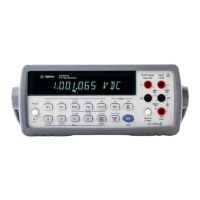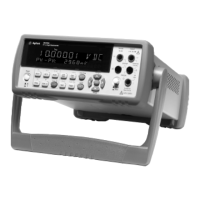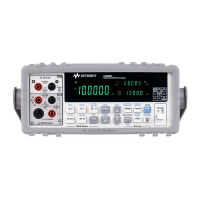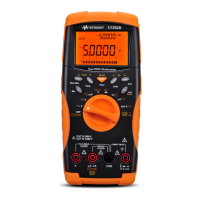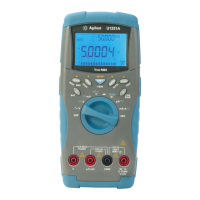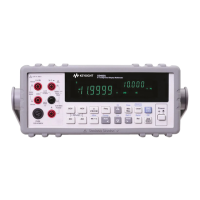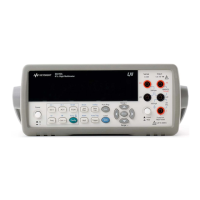144 Chapter 5 Digitizing
source event and the first sample in each burst; the default delay for
sub-sampling is 0 seconds.)
Sending Samples to
Memory
When samples are sent directly to reading memory (MEM FIFO command),
the multimeter automatically re-orders the samples producing a composite
waveform. For example, in the following program, the sub-sampled data is
sent to reading memory using the required SINT memory format. The
multimeter places the samples in memory in the corrected order. The samples
are then transferred to the controller using the DREAL output format (when
placing sub-sampled data in reading memory first, you are not restricted to
using the SINT output format).
10OPTION BASE 1 !COMPUTER ARRAY NUMBERING STARTS AT 1
20REAL Samp(l:200) BUFFER !CREATE BUFFER ARRAY
30ASSIGN @Dvm TO 722 !ASSIGN MULTIMETER ADDRESS
40ASSIGN @Samp TO BUFFER Samp(*) !ASSIGN BUFFER
50OUTPUT @Dvm;"PRESET FAST" !TARM SYN, TRIG AUTO, DINT FORMATS
60OUTPUT @Dvm;"MEM FIFO" !FIRST-IN-FIRST-OUT READING MEMORY
70OUTPUT @Dvm;"MFORMAT SINT" !SINT MEMORY FORMAT
80OUTPUT @Dvm;"OFORMAT DREAL" !DOUBLE REAL OUTPUT FORMAT
90OUTPUT @Dvm;"SSDC 10" !SUB-SAMPLING, 10V RANGE, DC-COUPLED
100OUTPUT @Dvm;"SWEEP 5E-6,200" !5µs EFF. INTERVAL, 200 SAMPLES
110TRANSFER @Dvm TO @Samp;WAIT !TRANSFER SAMPLES TO CONTROLLER BUFFER
120FOR I=1 TO 200
130 IF ABS(Samp(I))=lE+38 THEN !DETECT OVERLOAD
140 PRINT "Overload Occurred" !PRINT OVERLOAD MESSAGE
150 ELSE !IF NO OVERLOAD OCCURRED:
160 Samp(I)=DROUND(Samp(I),5) !ROUND TO 5 DIGITS
170 PRINT Samp(I) !PRINT EACH SAMPLE
180 END IF
190NEXT I
200END
Sending Samples to
the Controller
When samples are sent directly to the controller, an algorithm must be used
to re-order the samples and produce the composite waveform. The
SSPARM? command returns three parameters for the algorithm. The first
parameter returned is the number of bursts measured that contained N
samples. The second parameter returned is the number of bursts measured
that contained N-1 samples. The third parameter returned is the value of N.
For example, assume you are sub-sampling a 10kHz signal and specify 22
samples with an effective_interval of 5µs. In this example, the multimeter
takes 2 bursts containing 6 samples each and 2 bursts containing 5 samples
each. Each burst is delayed 5µs from the previous burst. The values returned
by SSPARM? are then 2, 2, and 6.
When sub-sampling, the maximum sample rate is 50k samples per second
regardless of the specified effective_interval. (If you specify an
effective_interval of ³20µs, the multimeter is no longer sub-sampling but
direct-sampling.) When sending samples directly to the controller (using the
required SINT format which is 2-bytes per sample) the GPIB/controller must
be able to handle the data at a maximum rate of 100k-bytes per second. If
not, the multimeter generates the TRIGGER TOO FAST error.
In the program on the following page, the SSAC command is used to digitize
a 10 kHz signal with a peak value of 5V. The SWEEP command instructs
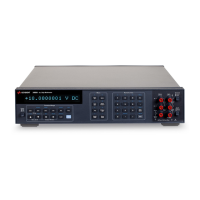
